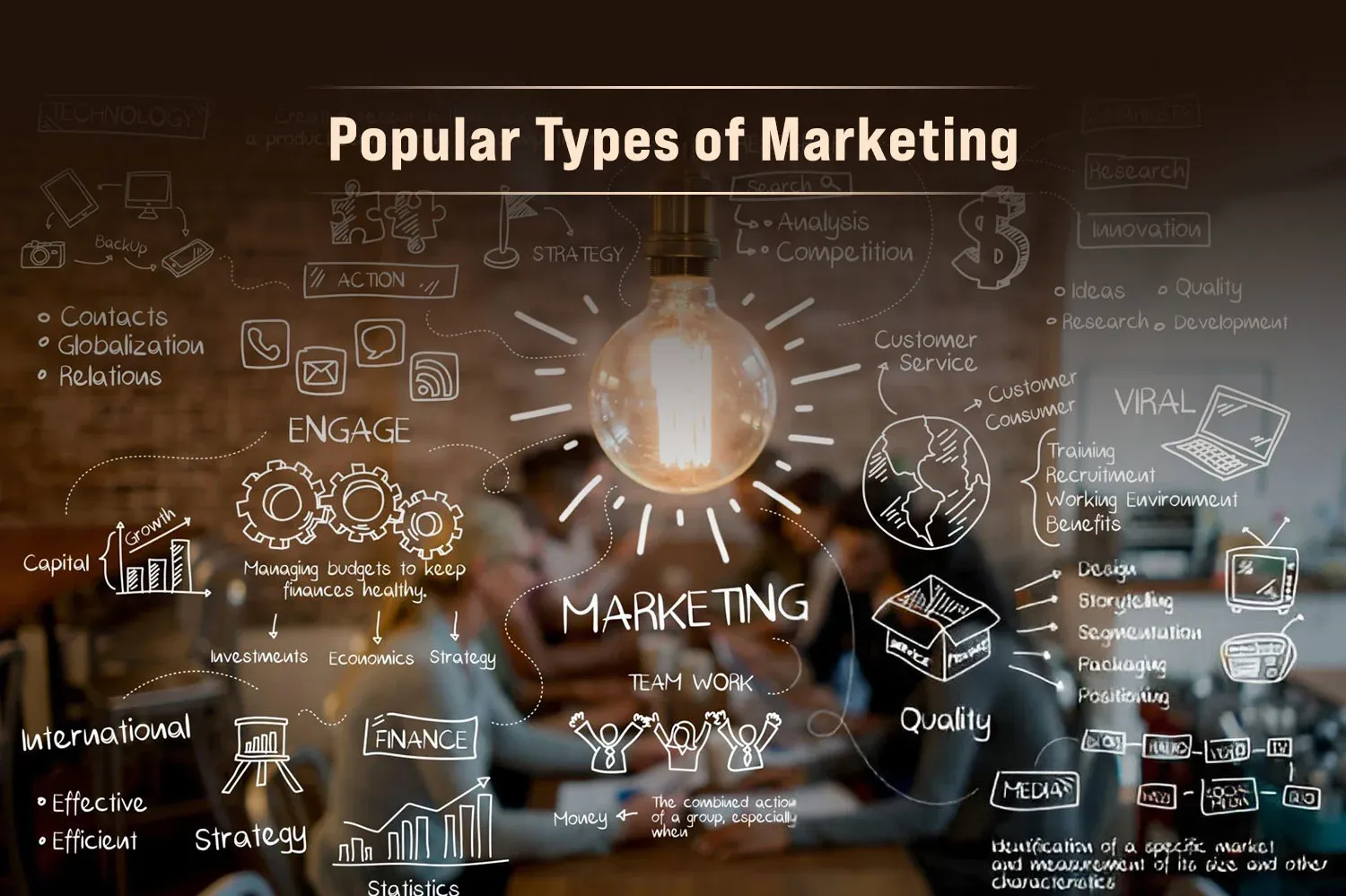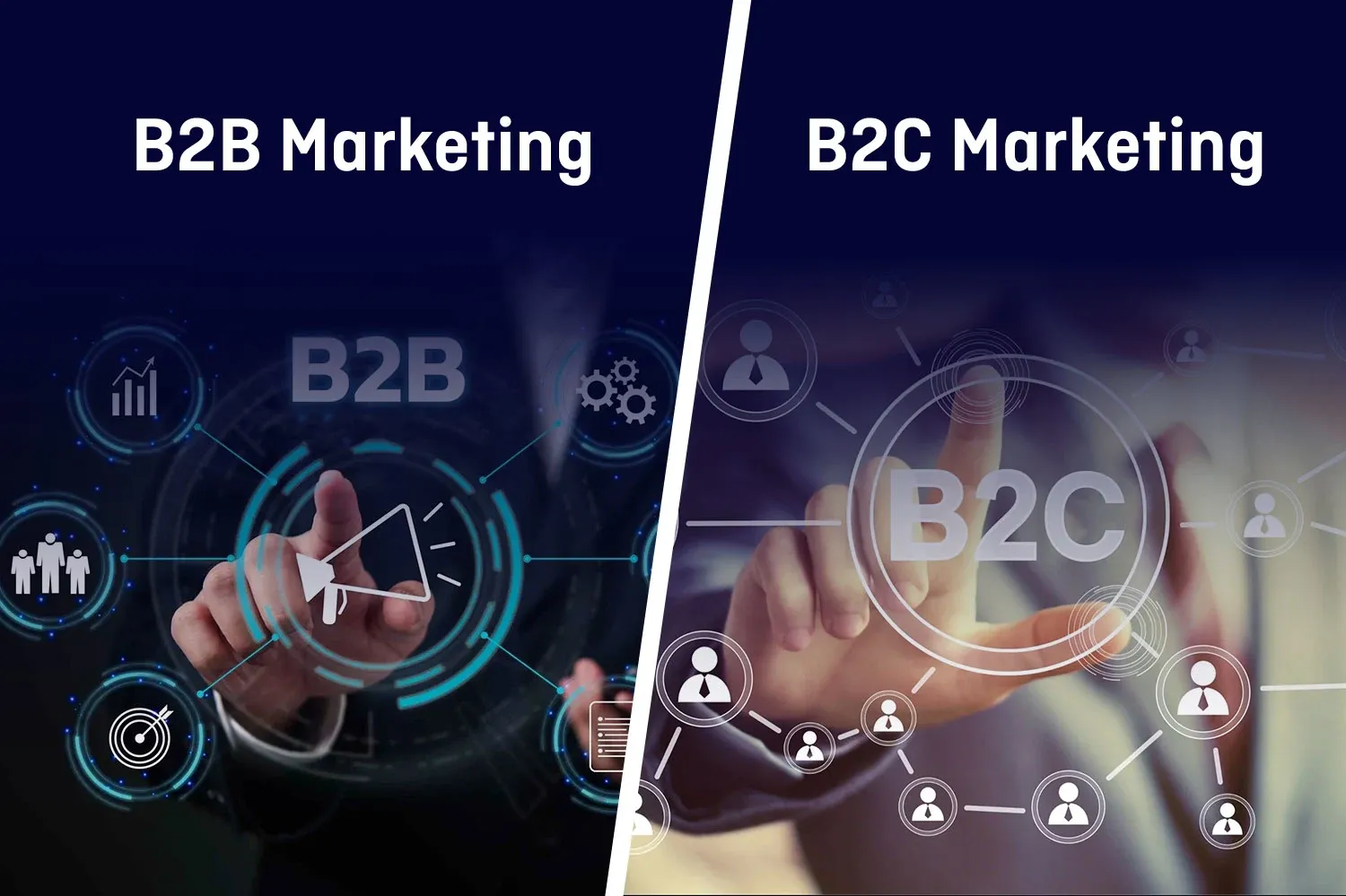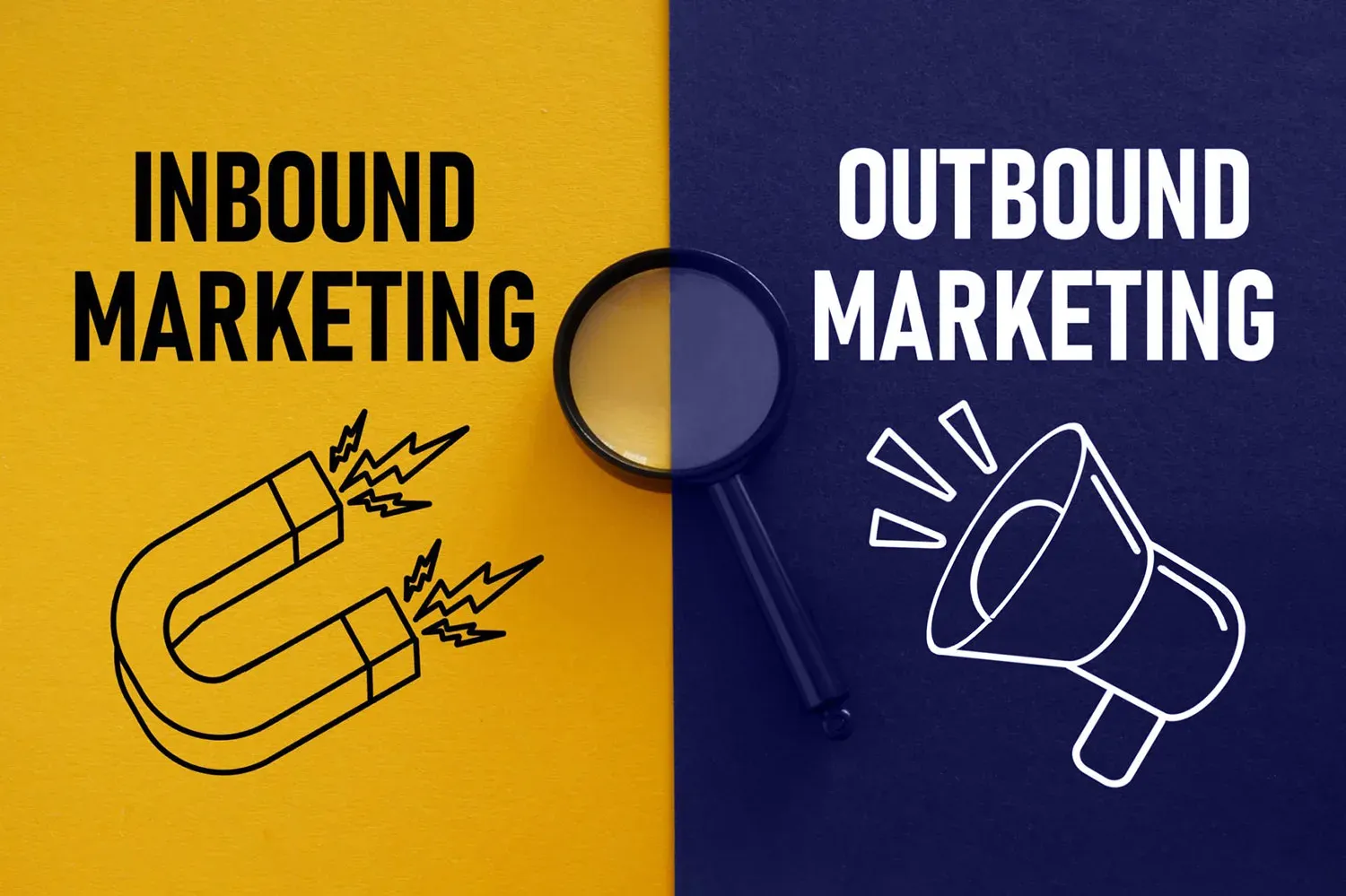Types of Marketing to Promote Your Brand

Marketing is the cornerstone of business success. In accordance with the unique consumer behaviors seen today, brands have more ways than ever to connect with their target audiences, thanks to the rapid advancements in technology. However, mastering marketing still remains a challenge, which requires the understanding of a broad range of strategies available and how to use them effectively.
In this article, we’ll walk you through the most popular types of marketing, break down B2B vs. B2C marketing, explain inbound vs. outbound approaches, and help you figure out how to choose the right mix for your business.
Popular Types of Marketing
Businesses have countless ways to market their offerings. Here are the most common ways of marketing leveraged today:

Content Marketing
Content marketing focuses on crafting and sharing high-quality, pertinent, and regular material to captivate and retain a specific target demographic. It builds trust, educates potential customers, and nurtures leads over time, ultimately driving profitable customer actions without overtly selling. Blogs, eBooks, videos, and infographics are commonly used formats of content marketing.
Social Media Marketing
Social media marketing harnesses the power of digital networks including platforms such as Facebook, Instagram, LinkedIn, and TikTok to amplify brand messaging and drive product or service awareness. It helps brands connect directly with their audience, boost visibility, foster engagement, and drive sales through organic content and paid ads. Consistency and audience interaction are key to building long-term social relationships.
Influencer Marketing
Influencer marketing collaborates with individuals having significant online followings to promote products authentically. These influencers produce authentic content that connects deeply with specialized audiences, fostering stronger trust and interaction. It’s especially effective for lifestyle, fashion, and tech brands seeking credibility and exposure in competitive or crowded markets.
Email Marketing
Email marketing delivers tailored communications straight to subscribers’ inboxes, serving as a tool for updates, promotions, and lead nurturing to drive customer retention. With segmentation and automation tools, email remains a cost-effective, measurable, and personal way to engage customers and drive consistent, long-term brand loyalty.
Search Engine Marketing (SEM)
SEM refers to paid strategies like Google Ads that place your website in front of users actively searching for relevant terms. This approach provides instant exposure, attracts motivated visitors, and delivers quantifiable outcomes, with precise targeting options for efficient spending and performance analysis.
Search Engine Optimization (SEO)
SEO enhances a site’s discoverability in search engine results by fine-tuning textual elements, technical framework, and external linking strategies. It drives organic, long-term traffic from users searching for relevant keywords. By enhancing user experience, relevance, and technical performance, SEO builds credibility, lowers acquisition costs, and supports sustainable growth in competitive digital environments.
Print Marketing
Print marketing utilizes tangible mediums like flyers, brochures, posters, and magazine advertisements for brand promotion. Despite digital growth, it remains powerful for reaching local audiences, enhancing brand credibility, and creating tangible impressions. High-quality design, strategic distribution, and consistent messaging are essential for making print marketing memorable and action oriented.
Public Relations (PR)
PR shapes public perception through media relations, press releases, and narrative strategies to bolster trust and manage brand image. Effective PR aligns brand messaging with public sentiment, creating positive associations that support long-term marketing and business goals.
Direct Mail
Direct mail delivers promotional materials like catalogs, postcards, or letters straight to customers’ physical mailboxes. It’s highly targeted and can be personalized for better engagement. When executed creatively, direct mail offers a tactile, attention-grabbing way to stand out, especially for local businesses or high-value campaigns.
Pay-Per-Click (PPC) Marketing
PPC advertising operates on a cost-per-click basis, ensuring businesses pay exclusively for actual user engagement with their advertisements. Common on platforms like Google and Bing, PPC enables precise targeting by keywords, demographics, and location. It delivers fast visibility, real-time performance tracking, and scalable budgets, making it ideal for driving qualified traffic and measurable return on investment.
Partner Marketing
Partner marketing fosters alliances between businesses to achieve shared promotional objectives. By sharing audiences, resources, and expertise, partners can expand brand reach, enhance credibility, and increase sales. This strategy is effective for co-branded promotions, sponsorships, or bundled offerings, especially when targeting similar customer bases.
Telemarketing
Telemarketing engages prospects directly via phone calls to pitch products or services. Though its popularity has declined due to digital channels, telemarketing remains effective for lead generation, appointment setting, and personalized outreach. Success depends on compliance with regulations, skilled communication, persistence, and understanding customer needs beforehand.
Brand Marketing
Brand marketing focuses on building long-term brand awareness, loyalty, and emotional connection rather than immediate sales. It shapes public perception by emphasizing brand identity, values, storytelling, and consistent experiences across all touchpoints. Strong brand marketing ensures a company stands out in competitive markets, driving sustainable growth and customer trust.
Stealth Marketing
Stealth marketing subtly promotes products without overt advertising, often embedding brands within entertainment content or public spaces. Examples include product placements in movies or influencers using branded products naturally. It builds awareness organically by capturing attention in authentic contexts, increasing relatability, and minimizing consumer resistance to traditional ads.
Word-of-Mouth Marketing
Word-of-mouth marketing thrives on organic customer endorsements and peer recommendations. Highly trusted and cost-effective, it amplifies brand reputation through organic conversations, reviews, and referrals. Encouraging word-of-mouth through exceptional service, loyalty programs, or referral incentives can significantly boost credibility, customer acquisition, and long-term brand advocacy.
Cause Marketing
Cause marketing associates brands with societal or ecological initiatives to showcase ethical commitment and foster emotional bonds. By supporting initiatives customers care about, companies enhance loyalty and differentiate themselves. Successful cause marketing requires authenticity, transparency, and clear action, ensuring both societal impact and brand reputation uplift.
Affiliate Marketing
Affiliate marketing enlists external promoters to advocate for products in exchange for performance-based commissions. Affiliates, often bloggers or influencers, leverage their platforms to reach specific audiences. This model reduces initial expenditures, broadens audience reach, and offers clear ROI tracking.
Experiential Marketing
Experiential marketing crafts captivating, hands-on brand interactions that leave a lasting impression by directly immersing consumers in unique, brand-driven moments. Events like pop-ups, festivals, or interactive exhibits foster emotional connections, making the brand unforgettable. By offering hands-on involvement, experiential marketing drives word-of-mouth buzz, deepens brand loyalty, and encourages organic sharing across social and digital channels.
Interactive Marketing
Interactive marketing engages customers through dynamic experiences that encourage participation. Examples include quizzes, games, surveys, and personalized product recommendations. This approach increases user involvement, gathers valuable data, and creates more meaningful connections. Effective interactive marketing boosts engagement rates, enhances customer satisfaction, and strengthens loyalty through personalized experiences.
Mobile Marketing
Mobile marketing targets consumers via smartphones and tablets through SMS, push notifications, apps, and mobile-optimized websites. It ensures real-time, location-based engagement, capitalizing on the growing mobile-first consumer behavior. Successful mobile marketing emphasizes personalization, convenience, and value, helping brands drive app engagement, foot traffic, and instant purchasing decisions.
Video Marketing
Video marketing uses engaging visual content to promote products, explain services, or tell brand stories. It’s highly effective across digital platforms, boosting conversions, SEO, and audience retention. Videos enhance emotional appeal and clarity, making complex messages digestible while increasing brand visibility, trust, and social sharing opportunities in a saturated market.
Voice Marketing
Voice marketing targets users of voice-enabled devices like smart speakers and virtual assistants. Brands optimize content for voice search, create branded voice experiences, or run audio ads. This strategy taps into hands-free convenience, expanding reach and fostering accessibility, especially as voice commands become common in daily digital interactions.
Conversational Marketing
Conversational marketing uses real-time dialogue, often through chatbots or live messaging, to engage prospects and improve customer experience. It focuses on building relationships through personalized, two-way communication. This immediate interaction streamlines lead qualification, shortens sales cycles, and increases customer satisfaction by addressing queries when interest and intent are highest.
Buzz Marketing
Buzz marketing generates excitement and word-of-mouth through viral, often edgy or unconventional campaigns. It leverages suspense, surprise, or controversy to spark curiosity and discussions. When executed well, buzz marketing increases visibility rapidly, drives massive social engagement, and positions brands as culturally relevant — but requires risk management to avoid backlash.
Contextual Marketing
Contextual marketing delivers targeted messages based on a user’s behavior, location, or browsing activity. By aligning content with the user’s current situation or interest, this strategy increases relevance and engagement. It’s commonly seen in programmatic advertising, ensuring users receive timely, personalized messages that resonate and improve conversion potential.
Personalized Marketing
Personalized marketing tailors messages, offers, or experiences to individual customer preferences using data such as browsing history, demographics, or purchase behavior. This boosts relatability and interaction, improving conversion potential and brand allegiance. Examples include personalized emails, product recommendations, and targeted ads — all designed to make customers feel understood.
Product Marketing
Product marketing bridges innovation and market success through strategic positioning, messaging, and launch campaigns. The strategy ensures the product meets customer needs, communicates value clearly, and differentiates from competitors. Product marketers also gather feedback to improve offerings and support long-term growth.
Account-Based Marketing (ABM)
ABM is a precision-based B2B tactic where marketing and sales collaborate to customize outreach for key accounts. It focuses resources on decision-makers within key companies, using tailored messaging and offers. ABM increases conversion rates, shortens sales cycles, and strengthens relationships by delivering content that directly addresses unique business needs.
Campus Marketing
Campus marketing targets college students through on-campus events, brand ambassadors, sponsorships, and social media campaigns. It builds early brand affinity among young consumers, encouraging lifelong loyalty. This grassroots strategy taps into peer influence and community culture, making it effective for brands seeking to establish relevance with Gen Z and millennials.
Proximity Marketing
Proximity marketing uses technologies like Bluetooth, Wi-Fi, or beacons to deliver messages to customers based on their physical location. It’s effective in retail and events, sending real-time offers or updates when someone is near a store or booth. This tactic boosts foot traffic, engagement, and sales through hyper-local targeting.
Event Marketing
Event marketing amplifies brands via physical or digital gatherings like conferences, trade shows, or pop-up activations. It offers immersive brand experiences, fosters personal connections, and boosts engagement. Events foster lead generation, industry authority, and direct engagement, making them ideal for awareness and conversions.
Multicultural Marketing
Multicultural marketing tunes campaigns to resonate with diverse cultural, ethnic, and linguistic audiences. It involves culturally relevant messaging, imagery, and channels to build authentic connections. This inclusive approach increases brand reach, loyalty, and engagement by recognizing cultural nuances and demonstrating respect for the values, preferences, and identities of varied communities.
Controversial Marketing
Controversial marketing deliberately uses provocative themes or opinions to spark debate and attract attention. While effective for virality, it requires clear judgement to prevent audience backlash. When executed with purpose and authenticity, it can highlight social issues, differentiate a brand, and stimulate meaningful conversation around values.
Neuromarketing
Neuromarketing applies neuroscience to understand consumer behavior and decision-making. It uses brain imaging, biometrics, and psychological triggers to craft more persuasive messaging. Marketers gain insights into emotional responses, attention, and memory, helping them optimize content, design, and experiences for maximum impact. It bridges science and creativity to enhance effectiveness.
Podcast Marketing
Podcast marketing promotes products or services through podcast sponsorships, host-read ads, or branded series. It reaches highly engaged, niche audiences in a personal and conversational format. With long-form storytelling and trusted voices, podcast ads achieve high retention, authenticity, and ROI, making them ideal for brand awareness and thought leadership.
Relationship Marketing
Relationship marketing prioritizes enduring customer bonds over quick sales, cultivating loyalty through personalized value. By nurturing strong connections, brands increase customer lifetime value, reduce churn, and turn buyers into advocates. It's essential for sustainable growth in competitive markets.
Guerrilla Marketing
Guerrilla marketing employs bold, budget-friendly tactics to spark curiosity and memorable brand interactions. Often executed in public spaces, it relies on surprise, creativity, and virality. Effective guerilla campaigns generate buzz, boost word-of-mouth, and stretch limited budgets, making them ideal for startups or brands seeking bold visibility.
Acquisition Marketing
Acquisition marketing aims to attract and convert new customers using targeted marketing campaigns across various channels. It includes strategies like paid ads, SEO, content, and lead nurturing. The goal is securing premium leads, boosting sales, and expanding market presence. It’s data-driven, measurable, and essential for business expansion.
Retention Marketing
Retention marketing focuses on keeping existing customers engaged and loyal. By leveraging tailored messaging, rewards initiatives, and continuous value enhancement, businesses can minimize customer attrition while boosting loyalty-driven sales. Maintaining existing clients proves more economical than acquiring new ones, amplifying long-term profitability.
Emotional Marketing
Emotional marketing appeals to feelings like happiness, fear, nostalgia, or belonging to drive consumer action. By forming strong emotional bonds, it enhances memorability and brand connection. Emotional storytelling in ads or content encourages sharing and loyalty, making it a powerful strategy for differentiation in a saturated marketplace.
Seasonal Marketing
Seasonal marketing leverages specific times of the year—holidays, weather changes, or cultural events—to promote products or services. It creates urgency, boosts sales, and aligns messaging with seasonal trends. Effective seasonal campaigns involve planning, timing, and relevance, helping brands stay top-of-mind and maximize conversions during high-demand periods.
Global Marketing
Global marketing adapts strategies to resonate across diverse international markets. It requires adapting messaging, branding, and distribution to fit local cultures while maintaining a unified global identity. Successful global marketing expands brand reach, taps into new audiences, and ensures relevance across diverse regions through strategic localization and consistency.
Local Marketing
Local marketing targets specific geographic areas, focusing on community needs and preferences. It uses location-based tactics like local SEO, events, or area-specific promotions to attract nearby customers. This strategy strengthens customer relationships, boosts foot traffic, and enhances brand visibility within a community, making it ideal for small businesses and franchises.
Augmented Reality (AR) Marketing
AR marketing integrates digital overlays into real-world environments for engaging brand experiences. It boosts engagement, product visualization, and personalization, especially in retail and real estate. By blending entertainment and utility, AR marketing captivates users, differentiates brands, and enhances decision-making in immersive ways.
Understanding B2B vs. B2C Marketing
Distinguishing B2B from B2C marketing is crucial for developing audience-specific campaigns. Here's a breakdown of their key distinctions:

Aspect | B2B Marketing | B2C Marketing |
Decision-Making Process | It involves multiple stakeholders such as procurement, finance, and operations, which makes buying decisions complex and layered. | A single individual customer usually makes the decision to purchase, often quickly and independently. |
Buying Cycle Duration | Longer buying cycle due to strategic goals, product evaluations, and long-term investment. | Shorter buying cycle, especially for low-ticket items and impulsive purchases. |
Focus of Marketing Message | Emphasizes ROI, efficiency, and business value. Logical, fact-driven messaging dominates. | Focuses on emotional appeal, lifestyle fit, entertainment, and quick problem-solving. |
Content Strategy | Uses in-depth content like whitepapers, webinars, and case studies tailored to various decision stages. | Relies on engaging, simplified content like videos, social posts, and influencer campaigns. |
Importance of Reviews | Even negative reviews offer insight and are used to improve offerings and build trust. | Negative reviews can be damaging; businesses aim to avoid or suppress them to maintain brand image. |
Customer Relationships | Aims for long-term partnerships, often involving contracts and regular engagement. | Relationship longevity varies by product type; may be short-term and transactional. |
Understanding Outbound vs. Inbound Marketing
While both inbound and outbound marketing aim to drive customer acquisition, they operate from opposite ends of the spectrum, where one attracts while the other pursues. Here's a clear comparison to help you see how they diverge in approach and execution:

Aspect | Inbound Marketing | Outbound Marketing |
Approach | Pulls in audiences by offering valuable, relevant content. | Pushes messages to broad audiences regardless of interest. |
Audience Focus | Prioritizes the consumer’s needs and interests. | Focuses on brand promotion and product visibility. |
Communication Style | Two-way, engaging, and relationship-building. | One-way, message-centric and interruption-based. |
Mediums Used | Blogs, SEO, social media, opt-in emails, webinars, and influencer collaborations. | Cold emails, display ads, direct mail, TV/radio spots, and telemarketing. |
Measurability
| Simplifies monitoring user actions and evaluating campaign efficacy. | Harder to attribute specific outcomes to specific touchpoints. |
User Experience | Seamless and integrated with the audience’s journey. | Often intrusive or disruptive to the user’s experience. |
How to Choose the Right Mix of Marketing Types
Choosing the right mix of marketing types should be based on clear reasoning rather than guesswork. Here's a breakdown of how to approach this selection process:
Understand Your Goals
Start by defining what success looks like. Is your objective brand recognition, lead generation, immediate sales, or sustained customer relationships? Your goals will shape which marketing type you choose. For example, awareness campaigns might benefit from influencer and social media marketing, while conversions might rely more on SEO and email campaigns.
Know Your Target Audience
Your marketing won’t be effective if it doesn’t speak directly to the people you want to reach. Analyze your audience’s habits, pain points, preferences, and preferred platforms—digital or traditional. If your audience is Gen Z, for instance, TikTok or video marketing might outperform traditional email or direct mail tactics.
Budget and Resources
Some marketing strategies require more investment than others. PPC and event marketing, for example, can be costly, whereas content and SEO are more resource-intensive over time. Evaluate your internal team’s capacity and skills as well—if you lack in-house creatives, influencer or partner marketing might offer faster results.
Test Multiple Approaches
Avoid putting all your resources into one channel too early. Conduct pilot campaigns with varied tactics to gauge audience response. A/B testing your messaging across formats—like paid ads, blog posts, or social media—can help identify high-performing strategies before you scale.
Leverage Analytics and Refine Your Strategy
Marketing without measurement is just guesswork. Use tools like Google Analytics, CRM systems, or social media insights to track engagement, conversion rates, and ROI. Let the data guide your next steps—double down on what works and phase out or adjust what doesn’t.
Integrate the Different Types of Marketing for Cohesion
The best marketing strategies don’t operate in silos. Make sure your efforts across channels support each other—your email marketing should align with your social campaigns, your content should reinforce your SEO goals, and your PR efforts should enhance your brand story across all platforms.
Stay Flexible and Adaptable
Marketing trends, tools, and customer expectations evolve quickly. Stay informed and be ready to pivot. If a new platform gains traction or your audience's behavior shifts, be prepared to reallocate resources or test new formats to maintain relevance and competitiveness.
FAQ
Q1. What are the 4 Types of Marketing Management?
Ans: The four primary types of marketing management are:
- Strategic Marketing Management: Focuses on long-term goals and aligning marketing with the overall business strategy through careful planning, market analysis, and goal setting.
- Operational Marketing Management: Handles the daily execution of marketing plans, including campaigns, promotions, and performance tracking to ensure smooth implementation.
- Product Marketing Management: Centers on the positioning, messaging, and promotion of a specific product or service by understanding market needs and competitive dynamics.
- Digital Marketing Management: Involves managing digital channels like social media, search engines, and email to effectively engage audiences in the digital space.
Q2. How Many Types of Digital Marketing Are There?
Ans: Digital marketing spans SEO, PPC, social media, email, affiliate partnerships, influencer collaborations, video content, and beyond. Each plays a unique role depending on your goals, audience, and budget.
Summing Up
Marketing thrives on authentic engagement, value-driven strategies, and adaptability in a dynamic environment. By understanding the wide variety of marketing strategies available, from content marketing and SEO to experiential and AR marketing, you can create a tailored approach that aligns with your business goals, target audience, and available resources.
Whether you’re targeting businesses with B2B campaigns, engaging consumers directly through B2C strategies, or balancing inbound and outbound methods, the key to success lies in choosing the right mix of tactics, measuring performance, and continuously refining your efforts. As consumer behaviors and technologies evolve, staying flexible and open to innovation will help your brand stand out, foster loyalty, and drive sustainable growth.





